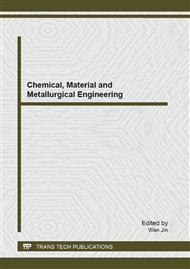p.179
p.186
p.192
p.197
p.203
p.211
p.215
p.220
p.229
Effect of Sonofication of Carbon Black and 3-Aminopropyltriethoxysilane (APTS) on the Properties of Rubber-Carbon Black Composite
Abstract:
In order to improve the mechanical properties of natural rubber so it can be used as raw material for industrial component, it is required to add filler and coupling agent to the natural rubber. In previous study, carbon black obtained from sonofication process for 3 and 5 hours was added (filled) to improve thermal and mechanical properties of rubber-carbon black, where the improvement was influenced by the period of sonofication of carbon black, which subsequently added to the rubber-carbon black composite.In this study, various rubber-carbon composites have been synthesized using thin pale crepe (TPC) natural rubber as matrix, strengthened by carbon black N 660, sonoficated N 660, and addition of 2 phr of 3-aminopropyltriethoxysilane (APTS) to each composite. The obtained rubber-carbon black composite was characterized by using Fourier Transform Infrared Spectroscopy (FTIR) and Scanning Electron Microscopy-Energy Dispersive X-Ray Spectroscopy (SEM-EDS). Universal Testing Machine was used to characterize its mechanical properties.Bound rubber value and mechanical properties of rubber-carbon black composite improved as a result of the addition of carbon black obtained from sonofication and APTS. However, contrast result was observed when sonoficated carbon black and APTS were added simultaneously.
Info:
Periodical:
Pages:
203-210
Citation:
Online since:
August 2013
Authors:
Price:
Сopyright:
© 2013 Trans Tech Publications Ltd. All Rights Reserved
Share:
Citation:


